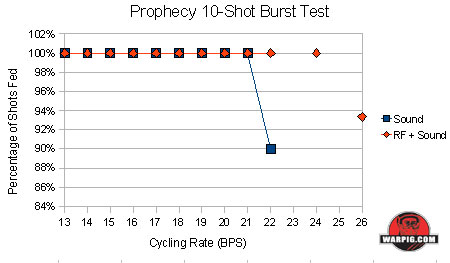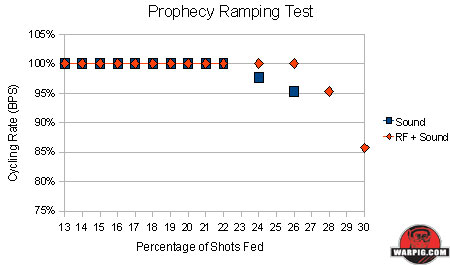  |
|
|
|
|
|
|
  |
|
|
|
|
|
|

Product Testing performed with DraXxus Paintballs provided by Procaps Direct What
do you think?
|
Empire Prophecy Loader
The first of these three settings, motor speed determines how fast the drive system will rotate. It is adjustable in six levels. The Prophecy manual points out that the highest motor speed setting will not necessarily yield the best loading times, a fact borne out by WARPIG.com testing of the Magna Drive Loader. The manual attributes this to excessive drive speeds causing the clutch to slip more often, actually resulting a lower speed for the feed carousel, and also notes that speeds higher than necessary for reliable feeding will result in less than optimum battery life. The sound sensitivity setting is also adjustable from 1 to 6. It defines the sound level necessary to activate the Prophecy. It can be set higher for quiet markers, to make sure the sound of their shooting triggers the feeding of a new paintball, or it can be set lower to minimize extraneous activation, which would burn through the batteries faster. Ball stack tension monitoring can be turned on or off. When activated, the Prophecy measures the electrical resistance of the motor to determine whether it is pressing against paintballs or freely turning. The loader can then respond by reducing current to the motor to prevent over-driving, as well as slowing the motor when there are only a few paintballs left, so that the lack of resistance on the feed carousel does not result in paintballs being flung too quickly into the feedneck.
Although the software in the Prophecy is adjustable, it is configured ready to turn on and go. To test the Magna Prophecy's performance it was put through both the WARPIG Ballistic Labs standardized 10-shot burst and 14-shot ramping feed tests. Testing was performed with both the magnetic clutch and the electronic settings in their default factory configuration.
The 10-shot burst test involves firing three 10-shot bursts at test rates of fire, and then continuing to the next higher rate if at least two of the three bursts fed flawlessly. This test is particularly demanding for loaders, and does not indicate the maximum rate at which a loader may feed, but rather the maximum rate that a loader may sustain over 10 shots, after starting from a dead-stop.  Starting at 13 balls per second with the sound of the Matrix LCD activating it, the Prophecy was tested at progressively faster cyclic rates, feeding without problem up to 22 balls per second, where it fed only 9 of ten paintballs on each of three trials. Connecting an Empire RF transmitter to the Matrix LCD circuit board, the results for the same test improved. After firing an initial shot, the Prophecy recognized the radio signal, confirming the connection with a change of its power LED color to blue. In RF mode the drive system also pulses occasionally, maintaining tension on the paintballs. With the RF link, the Prophecy fed at greater speeds, checking at even numbered rates of fire above 22 bps, the loader fed without error at 24 balls per second. At 26 bps two trials fed only 9 paintballs each while the third fed all ten. Sound activated, the Prophecy scored 21 bps on the 10-shot burst test, and 24 bps when radio activated. The 14-shot ramping test similarly checks for maximum rates of fire that can be sustained over 10 shots, but instead of starting the loader from a dead-stop, it is given a chance to ramp up to speed by first firing four shots at a rate of 10 balls per second. This test more more closely simulates firing conditions found in a paintball game where a player shoots progressively faster, or shoots in a ramping mode that increases progressively faster. The 4 bps starting rate gives loaders a chance to spin up, rather than drive at full speed from a dead start.  In the ramping test, the Prophecy fed error free with sound activation up through 22 balls per second. At 24bps, it fed properly for 2 out of 3 trials, advancing it to testing at 26 balls per second, where it fed one trial properly, and skipped a ball on each of the other two, for a score of 24bps. With the RF transmitter in operation, performance improved with perfect feeding up to 28 balls per second where two balls were skipped in the third trial for the highest score yet recorded on this test. At 30 balls per second, only 12 balls were fed on each of three trials. For full test data, click here. As the next generation in the HALO, and Magna line of loaders, the Prophecy employs the same operational concepts from previous models yet encorporates them in a new design built for simplicity of maintenance and adjustment with improved performance.
|
| Copyright © 1992-2019
Corinthian Media Services. WARPIG's webmasters can be reached through our feedback form. All articles and images are copyrighted and may not be redistributed without the written permission of their original creators and Corinthian Media Services. The WARPIG paintball page is a collection of information and pointers to sources from around the internet and other locations. As such, Corinthian Media Services makes no claims to the trustworthiness or reliability of said information. The information contained in, and referenced by WARPIG, should not be used as a substitute for safety information from trained professionals in the paintball industry. |